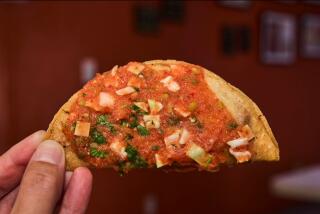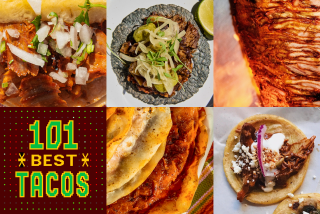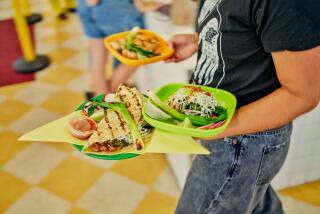Reviewing Intake of Fats, Calories
A recent Nutri-Data column focusing on the fight against fat and calories (Food Section, Sept. 4) generated some confusion among readers, who found recipes containing 14 to 23 grams of fat per serving to be excessive and not consistent with recommendations by heart and cancer groups advocating that we “cut back fat intake from the national average of approximately 40% of total calories to 30%.”
The article discussed research data collected by the Food Marketing Institute that displayed consumer preferences in making food choices. The study indicated that although most people are concerned about the nutritive value of food, taste is still a great motivator in terms of selection. The article went on to suggest fish recipes that satisfy consumers’ need for healthful foods without neglecting their taste buds.
Dropping Fat Intake The American Heart Assn. and other health and cancer groups have begun to support the notion that dietary fat should be restricted to a total of 30% of overall intake, down 10% from the previous caloric allotment, which allowed up to 40% of the day’s total calories to be derived from fat.
Intake watchers assume that under this policy, one recipe with a high fat and calorie content adversely affects the total fat consumption for the day. It is perceived, in effect, that if a recipe already contains as much as 50% fat, one would have to live on orange segments and plain produce to stay within the safe range for the day. This is not the case.
It must be made clear that we are talking about total daily caloric intake. Percentage of fat and calories for a day must be based upon everything we eat in that given day--not just by comparing the fat and calorie content for one recipe or meal.
For example, Salmon Tacos, one of the featured recipes, offers 14 grams of fat per taco serving. One gram of fat equals nine calories, so to get the number of calories per serving that are attributable to just fat, multiply 14 grams by nine--126 calories. Divide 126 by 233, the total number of calories per serving, and the 126 fat calories would represent 54% of the total calories for that dish.
This percentage seems extremely high, and it would be if this was the only meal eaten for a day. But when this 126 fat calories is compared to the typical safe dieting range of 1,000 to 1,200 total calories per day, the figure is considerably less--12% and 10% respectively. This falls well below the 30% recommended by the American Heart Assn.
Number of Calories a Day “It’s an overall intake of fat,” said Rita Storey, media spokeswoman for the American Dietetic Assn. “That means that in order to figure out what percentage of our daily intake the fat represents, we would have to have the nutrient data for everything eaten within a day. The key is how many calories you’re talking about for the day.”
The recipes provided in the September column emphasized good taste without compromising health concerns for fat and cholesterol. Recipes like Salmon Burgers and Salmon Tacos were considerably lower than their traditional counterparts--a typical 3 1/2-ounce serving of lean ground beef (10% fat) has 186 calories, compared to the same amount of salmon, which totals about 155. Included as part of a sensible daily eating plan, these recipes provide the dieter with needed variety and flexibility, yet fare quite well health-wise.
The question is: What is considered sensible?
A sample daily menu for persons on 1,800-calorie, fat-restricted diets might begin with breakfast foods selected from the following: a half grapefruit or a half cup orange slices; a half cup whole-wheat cooked cereal or one cup bran flakes; one cup skim milk; one homemade muffin or one slice whole-wheat toast and one ounce mozzarella cheese; and black coffee. Followed by a moderate lunch--tuna salad sandwich on whole-wheat bread with lettuce and tomato, one medium-size apple and one cup skim milk--you could easily afford to choose a more liberal dinner menu.
When included with the following breakfast and lunch menus, a person will spend 29% of the total day’s calories on fat when the dinner meal is Salmon Tacos. If Salmon Burgers are selected, the figure is 31%. It’s easy to manipulate these figures a bit; simply exclude more fatty parts of the meals to reach the desired goal.
Some other heart association suggestions:
Consume several servings of fruits and vegetables per day in organic form with edible peels for fiber rather than as juice. You should have three servings of fruit per day, of which at least one is high in Vitamin C and one rich in Vitamin A per week. Include three servings of vegetables per day--at least half to one cup cooked or raw--one high in Vitamin C every day and at least one serving from the high Vitamin A list several times a week.
Eat at least two servings per day of milk products fortified with Vitamins A and D, substituting either eight ounces low-fat or skim milk yogurt, two ounces low-fat cheese or a half cup low-fat cottage cheese for each serving.
Eat More Fish Than Red Meat Consume no more than five to seven ounces of meat, poultry or seafood per day: one chicken breast half or leg and thigh, a half cup flaked fish or two thin slices lean roast beef. Use poultry without skin, and eat fish more often than red meat. Use low-fat luncheon meats that have no more than two grams of fat per ounce, such as turkey or chicken roll, turkey ham, turkey pastrami or lean boiled ham.
Depending upon the types of foods chosen for the liberal meal, you could also afford some desserts, beverages and snacks from the association’s OK list of those that are low in saturated fat and fairly low in calories: frozen or canned fruit with sugar, dried fruits, seeds, nuts, plain popcorn, pretzels, certain crackers or cookies, sherbet, ice milk, frozen or fruited low-fat yogurt and angel food cake.
Some other choices, which are higher in calories, somewhat low in fat but very low in nutrition: hard candy, gum drops, flavored gelatin, frozen ice bars and fudge bars on sticks, water ices, fruit punches, carbonated drinks, sugar, syrup, honey, jam, jelly, marmalade, homemade desserts and alcoholic beverages.
The key to all of this, according to Storey, is conscientious eating--especially for those on a restricted-calorie diet. You have to be “more prudent” when making food selections; however, the more calories you have to work with, the more leeway you have in meal planning.
“It is very confusing,” said Storey, “because when you start talking about numbers people get very carried away. In the final analysis it’s what we do on a consistent basis that truly counts. You might be up one day and down the next.”
BREAKFAST
1/2 grapefruit
1 cup bran flakes
1/2 cup skim milk
1 cup black coffee
1 slice whole-wheat toast
1 ounce mozzarella cheese
PER SERVING: 327 calories; 19 gm protein; 57 gm carbohydrate; 6 gm fat; 544 mg sodium; 600 mg potassium.
USRDA
Protein 29% Riboflavin 51% Vitamin A 38% Niacin 28% Vitamin C 85% Calcium 42% Thiamine 37% Iron 77%
LUNCH
1 (7-ounce) can tuna
1 hard-cooked egg, chopped
2 tablespoons chopped celery
4 teaspoons finely chopped onion
3 tablespoons mayonnaise
8 slices whole-wheat bread
4 leaves butter lettuce
1 medium tomato, cut in thin slices
4 apples
4 cups skim milk
Combine tuna, egg, celery and onion in bowl. Stir in mayonnaise. Spread on 4 slices bread. Top each with 1 lettuce leaf and 2 tomato slices. Top with remaining bread slices. Serve tuna sandwich with 1 apple and 1 cup milk. Makes 4 servings.
PER SERVING: 464 calories; 30 gm protein; 61 gm carbohydrate; 13 gm fat; 474 mg sodium; 927 mg potassium.
USRDA
Protein 46% Riboflavin 38% Vitamin A 15% Niacin 42% Vitamin C 27% Calcium 38% Thiamine 21% Iron 20%
SALMON TACOS
12 (6-inch) corn tortillas
7 tablespoons olive oil
6 radishes
1 cup loosely packed cilantro
1 cup chopped, peeled cucumbers
2 tablespoons chopped red onion
2 tablespoons chopped tomato
3 tablespoons minced, seeded jalapeno chiles
1/3 cup grapefruit juice
3 tablespoons orange juice
2 tablespoons lime juice
1/4 teaspoon salt
1 avocado
4 cups shredded romaine lettuce
1 (15 1/2-ounce) can pink salmon, drained
Lightly fry tortillas in 5 tablespoons oil and drain thoroughly on paper towels. Process radishes and cilantro in food processor until finely minced. Set aside.
Place cucumbers, onion, tomato and chiles in bowl. Add grapefruit, orange and lime juices and salt and allow to marinate 30 minutes. Peel and slice avocado into 12 pieces.
Assemble each taco by layering tortilla with lettuce, cucumber mixture, radish mixture, salmon, avocado slice and drizzling with 1/2 teaspoon olive oil. Makes 12 servings.
Note: For fewer calories, omit avocado and heat tortillas in low oven for soft shell tacos.
PER SERVING: 233 calories; 10 gm protein; 18 gm carbohydrate; 14 gm fat; 197 mg sodium; 392 mg potassium.
USRDA
Protein 16% Riboflavin 10% Vitamin A 20% Niacin 20% Vitamin C 48% Calcium 16% Thiamine 07% Iron 12%
SALMON BURGERS
1 (15 1/2-ounce) can pink salmon
1 egg white
1/2 cup chopped onion
1/2 cup finely chopped green pepper
1/2 cup fresh whole-wheat bread crumbs
1 tablespoon lemon juice
1 teaspoon grated lemon peel
1/2 teaspoon rosemary leaves, crushed
1/8 teaspoon black pepper
1/4 cup oil
Drain salmon, reserving 2 tablespoons liquid. Flake. Combine salmon, egg white, onion, green pepper, bread crumbs, reserved liquid, lemon juice and peel, rosemary and pepper. Mix well. Form into 4 patties.
Heat oil in non-stick skillet and pan-fry patties about 5 minutes or until lightly browned. Turn halfway through cooking time. Makes 4 servings.
Note: If desired, serve with choice of toppings: sliced tomato, sliced pickles, chopped onion, sliced cheese, pickle or mustard relish, catsup, mayonnaise, mustard, tartar sauce or Thousand Island dressing or lettuce. Nutrient data does not include toppings.
PER SERVING: 336 calories; 26 gm protein; 11 gm carbohydrate; 21 gm fat; 538 mg sodium; 543 mg potassium.
USRDA
Protein 41% Riboflavin 16% Vitamin A 03% Niacin 48% Vitamin C 48% Calcium 25% Thiamine 06% Iron 09%
More to Read
Eat your way across L.A.
Get our weekly Tasting Notes newsletter for reviews, news and more.
You may occasionally receive promotional content from the Los Angeles Times.










